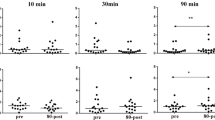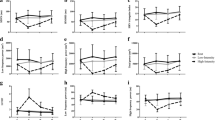Abstract
Lung oxidative stress (OS) was explored in resting and in exercising subjects exposed to moderate and high altitude. Exhaled breath condensate (EBC) was collected under field conditions in male high-competition mountain bikers performing a maximal cycloergometric exercise at 670 m and at 2,160 m, as well as, in male soldiers climbing up to 6,125 m in Northern Chile. Malondialdehyde concentration [MDA] was measured by high-performance liquid chromatography in EBC and in serum samples. Hydrogen peroxide concentration [H2O2] was analysed in EBC according to the spectrophotometric FOX2 assay. [MDA] in EBC of bikers did not change while exercising at 670 m, but increased from 30.0±8.0 to 50.0±11.0 nmol l−1 (P<0.05) at 2,160 m. Concomitantly, [MDA] in serum and [H2O2] in EBC remained constant. On the other hand, in mountaineering soldiers, [H2O2] in EBC under resting conditions increased from 0.30±0.12 μmol l−1 at 670 m to 1.14±0.29 μmol l−1 immediately on return from the mountain. Three days later, [H2O2] in EBC (0.93 ±0.23 μmol l−1) continued to be elevated (P<0.05). [MDA] in EBC increased from 71±16 nmol l−1 at 670 m to 128±26 nmol l−1 at 3,000 m (P<0.05). Changes of [H2O2] in EBC while ascending from 670 m up to 3,000 m inversely correlated with concomitant variations in HbO2 saturation (r=−0.48, P<0.05). AMS score evaluated at 5,000 m directly correlated with changes of [MDA] in EBC occurring while the subjects moved from 670 to 3,000 m (r=0.51, P<0.05). Lung OS may constitute a pathogenic factor in AMS.






Similar content being viewed by others
References
Arnould T, Michiels C, Janssens D, Delaive E, Remacle J (1995) Hypoxia induces PMN adherence to umbilical vein endothelium. Cardiovasc Res 30:1009–1016
Asami S, Hirano T, Yamaguchi R, Tsurudome Y, Itoh H, Kasai H (1998) Effects of forced and spontaneous exercise on 8-hydroxydeoxyguanosine levels in rat organs. Biochem Biophys Res Commun 243:678–682
Bailey DM, Davies B (2001) Acute mountain sickness; prophylactic benefits of antioxidant vitamin supplementation at high altitude. High Alt Med Biol 2:21–29
Bailey DM, Davies B, Young IS, Hullin DA, Seddon PS (2001) A potential role for free radical-mediated skeletal muscle soreness in the pathophysiology of acute mountain sickness. Aviat Space Environ Med 72:513–521
Bailey DM, Kleger GR, Holzgraefe M, Ballmer PE, Bartsch P (2004) Pathophysiological significance of peroxidative stress, neuronal damage, and membrane permeability in acute mountain sickness. J Appl Physiol 96:1459–1463
Baldwin SR, Simon RH, Grum CM, Ketai LH, Boxer LA, Devall LJ (1986) Oxidant activity in expired breath of patients with adult respiratory distress syndrome. Lancet 1(8471):11–14
Beck-Schimmer B, Schimmer RC, Madjdpour C, Bonvini JM, Pasch T, Ward PA (2001) Hypoxia mediates increased neutrophil and macrophage adhesiveness to alveolar epithelial cells. Am J Respir Cell Mol Biol 25:780–787
Behn C, Estrada MI, Dávila E, Araneda O,González M, Soria R (1999) Altitude related changes in red blood cell membrane lipids and proteins. Possible link with redox equilibrium, acid-base status and cell calcium.Trace Elem Man Anim 10:399–404
Carpagnano GE, Kharitonov SA, Resta O, Foschino-Barbaro MP, Gramiccioni E, Barnes PJ (2002) Increased 8-isoprostane and interleukin-6 in breath condensate of obstructive sleep apnea patients. Chest 122:1162–1167
Carpenter C, Price P, Christman B (1998) Exhaled breath condensate isoprostanes are elevated in patients with acute lung injury or ARDS. Chest 114:1653–1659
Casillan AJ, Gonzalez NC, Johnson JS, Steiner DR, Wood JG (2003) Mesenteric microvascular inflammatory responses to systemic hypoxia are mediated by PAF and LTB4. J Appl Physiol 94:2313–2322
Celedón G, González G, Sotomayor CP, Behn C (1998) Membrane lipid diffusion and band 3 protein changes in human erythrocytes due to acute hypobaric hypoxia. Am J Physiol 275:C1429–C1431
Corradi M, Rubinstein I, Andreoli R, Manini P, Caglieri A, Poli D, Alinovi R, Mutti A (2003) Aldehydes in exhaled breath condensate of patients with chronic obstructive pulmonary disease. Am J Respir Crit Care Med 167:1380–1386
Cracowski JL, Cracowski C, Bessard G, Pepin JL, Bessard J, Schwebel C, Stanke-Labesque F, Pison C (2001) Increased lipid peroxidation in patients with pulmonary hypertension. Am J Respir Crit Care Med 164:1038–1042
Eldridge MW, Braun RK, Yoneda KY, Walby WF, Bennett S, Hyde DM (1998) Lung injury after heavy exercise at altitude. Chest 114:66S–67S
Garey KW, Neuhauser MM, Robbins RA, Danziger LH, Rubinstein I (2004) Markers of inflammation in exhaled breath condensate of young healthy smokers. Chest 125:22–26
González G, Celedón G, Sandoval M, González GE, Ferrer V, Astete R, Behn C (2002) Hypobaric hypoxia-reoxygenation diminishes band 3 protein functions in human erythrocytes. Pflügers Arch 445:337–341
Hackett P, Oelz O (1992) The Lake Louise consensus on the definition and quantification of altitude illnes. In: Sutton JR, Coates G, Houston CS (eds) Hypoxia and mountain medicine. Queen City Printers, Burlington, pp 327–330
Hassoun PM, Yu FS, Cote CG, Zulueta JJ, Sawhney R, Skinner KA, Skinner HB, Parks DA, Lanzillo JJ (1998) Upregulation of xanthine oxidase by lipopolysaccharide, interleukin-1, and hypoxia. Role in acute lung injury. Am J Respir Crit Care Med 158:299–305
Horvath I, Donnelly LE, Kiss A, Kharitonov SA, Lim S, Fan Chung K, Barnes PJ (1998) Combined use of exhaled hydrogen peroxide and nitric oxide in monitoring asthma. Am J Respir Crit Care Med 158:1042–1046
Hoshikawa Y, Ono S, Suzuki S, Tanita T, Chida M, Song C, Noda M, Tabata T, Voelkel NF, Fujimura S (2001) Generation of oxidative stress contributes to the development of pulmonary hypertension induced by hypoxia. J Appl Physiol 90:1299–1306
Jackson RM, Parish G, Ho YS (1996) Effects of hypoxia on expression of superoxide dismutases in cultured ATII cells and lung fibroblasts. Am J Physiol 271:L955–L962
Joanny P, Steinberg J, Robach P, Richalet JP, Gortan C, Gardette B, Jammes Y (2001) Operation Everest III (Comex’97): the effect of simulated sever hypobaric hypoxia on lipid peroxidation and antioxidant defence systems in human blood at rest and after maximal exercise. Resuscitation 49:307–314
Larstad M, Ljungkvist G, Olin AC, Toren K. (2002) Determination of malondialdehyde in breath condensate by high-performance liquid chromatography with fluorescence detection. J Chromatogr B Analyt Technol Biomed Life Sci 766:107–114
Loukides S, Bouros D, Papatheodorou G, Lachanis S, Panagou P, Siafakas NM (2002) Exhaled H2O2 in steady-state bronchiectasis: relationship with cellular composition in induced sputum, spirometry, and extent and severity of disease. Chest 121:81–87
Madjdpour C, Jewell UR, Kneller S, Ziegler U, Schwendener R, Booy C, Klausli L, Pasch T, Schimmer RC, Beck-Schimmer B (2003) Decreased alveolar oxygen induces lung inflammation. Am J Physiol Lung Cell Mol Physiol 284:L360–L367
Merker MP, Pitt BR, Choi AM, Hassoun PM, Dawson CA, Fisher AB (2000) Lung redox homeostasis: emerging concepts. Am J Physiol Lung Cell Mol Physiol 279:L413–L417
Minko T, Stefanov A, Pozharov V (2002) Lung edema clearence: 20 years of progress selected contribution : lung hypoxia:antioxidant and antiapoptotic effects of liposomal α-tocopherol. J Appl Physiol 93:1550–1560
Montuschi P, Ciabattoni G, Paredi P, Pantelidis P, du Bois RM, Kharitonov SA, Barnes PJ (1998) 8-Isoprostane as a biomarker of oxidative stress in interstitial lung diseases. Am J Respir Crit Care Med 158:1524–1527
Montuschi P, Kharitonov SA, Ciabattoni G, Corradi M, van Rensen L, Geddes DM, Hodson ME, Barnes PJ (2000) Exhaled 8-isoprostane as a new non-invasive biomarker of oxidative stress in cystic fibrosis. Thorax 55:205–209
Nakanishi K, Tajima F, Nakamura A, Yagura S, Ookawara T, Yamashita H, Suzuki K, Taniguchi N, Ohno H (1995) Effects of hypobaric hypoxia on antioxidant enzymes in rats. J Physiol 489:869–876
Nielsen VG, Tan S, Weinbroum A, McCammon AT, Samuelson PN, Gelman S, Parks DA (1996) Lung injury after hepatoenteric ischemia-reperfusion: role of xanthine oxidase. Am J Respir Crit Care Med 154:1364–1369
Nourooz-Zadeh J, Tajaddini-Sarmadi J, Wolff SP (1994) Measurement of plasma hydroperoxide concentrations by the ferrous oxidation-xylenol orange assay in conjunction with triphenylphosphine. Anal Biochem 220:403–409
Nowak D, Kalucka S, Bialasiewicz P, Krol M (2001) Exhalation of H2O2 and thiobarbituric acid reactive substances (TBARs) by healthy subjects. Free Radic Biol Med 30:178–186
Radak Z, Nakamura A, Nakamoto H, Asano K, Ohno H, Goto S (1998) A period of anaerobic exercise increases the accumulation of reactive carbonyl derivatives in the lungs of rats. Pflugers Arch 435:439–441
Reddy KV, Kumar TC, Prasad M, Reddanna P (1998) Pulmonary lipid peroxidation and antioxidant defenses during exhaustive physical exercise: the role of vitamin E and selenium. Nutrition 14:448–451
Russell WJ, Ho YS, Parish G, Jackson RM (1995) Effects of hypoxia on MnSOD expression in mouse lung. Am J Physiol 269:L221–L226
Sulkowska M (1997) Morphological studies of the lungs in chronic hypobaric hypoxia. Pol J Pathol 48:225–234
Szkudlarek U, Maria L, Kasielski M, Kaucka S, Nowak D (2003) Exhaled hydrogen peroxide correlates with the release of reactive oxygen species by blood phagocytes in healthy subjects. Respir Med 97:718–725
Sznajder JI, Fraiman A, Hall JB, Sanders W, Schmidt G, Crawford G, Nahum A, Factor P, Wood LD (1989) Increased hydrogen peroxide in the expired breath of patients with acute hypoxemic respiratory failure. Chest 96:606–612
Vasankari TJ, Kujala UM, Rusko H, Sarna S, Ahotupa M (1997) The effect of endurance exercise at moderate altitude on serum lipid peroxidation and antioxidative functions in humans. Eur J Appl Physiol Occup Physiol 75:396–399
Wilhelm J, Frydrychova M, Vizek M (1999) Hydrogen peroxide in the breath of rats: the effects of hypoxia and paraquat. Physiol Res 48:445–449
Wilhelm J, Vankova M, Maxova H, Siskova A (2003) Hydrogen peroxide production by alveolar macrophages is increased and its concentration is elevated in the breath of rats exposed to hypoxia: relationship to lung lipid peroxidation. Physiol Res 52:327–332
Wood JG, Johnson JS, Mattioli LF, Gonzalez NC (2000) Systemic hypoxia increases leukocyte emigration and vascular permeability in conscious rats. J Appl Physiol 89: 1561–1568
Acknowledgements
We thank Mr. Luis Pizarro and Mr. Humberto Monsalve for skilful technical help. Valuable facilities for realization of the present work were kindly provided both by Federación Chilena de Ciclismo and by Escuela de los Servicios y Educación Física del Ejército de Chile. Financially, the work was supported by FONDECYT Project Nr. 1000858.
Author information
Authors and Affiliations
Corresponding author
Rights and permissions
About this article
Cite this article
Araneda, O., García, C., Lagos, N. et al. Lung oxidative stress as related to exercise and altitude. Lipid peroxidation evidence in exhaled breath condensate: a possible predictor of acute mountain sickness. Eur J Appl Physiol 95, 383–390 (2005). https://doi.org/10.1007/s00421-005-0047-y
Accepted:
Published:
Issue Date:
DOI: https://doi.org/10.1007/s00421-005-0047-y




